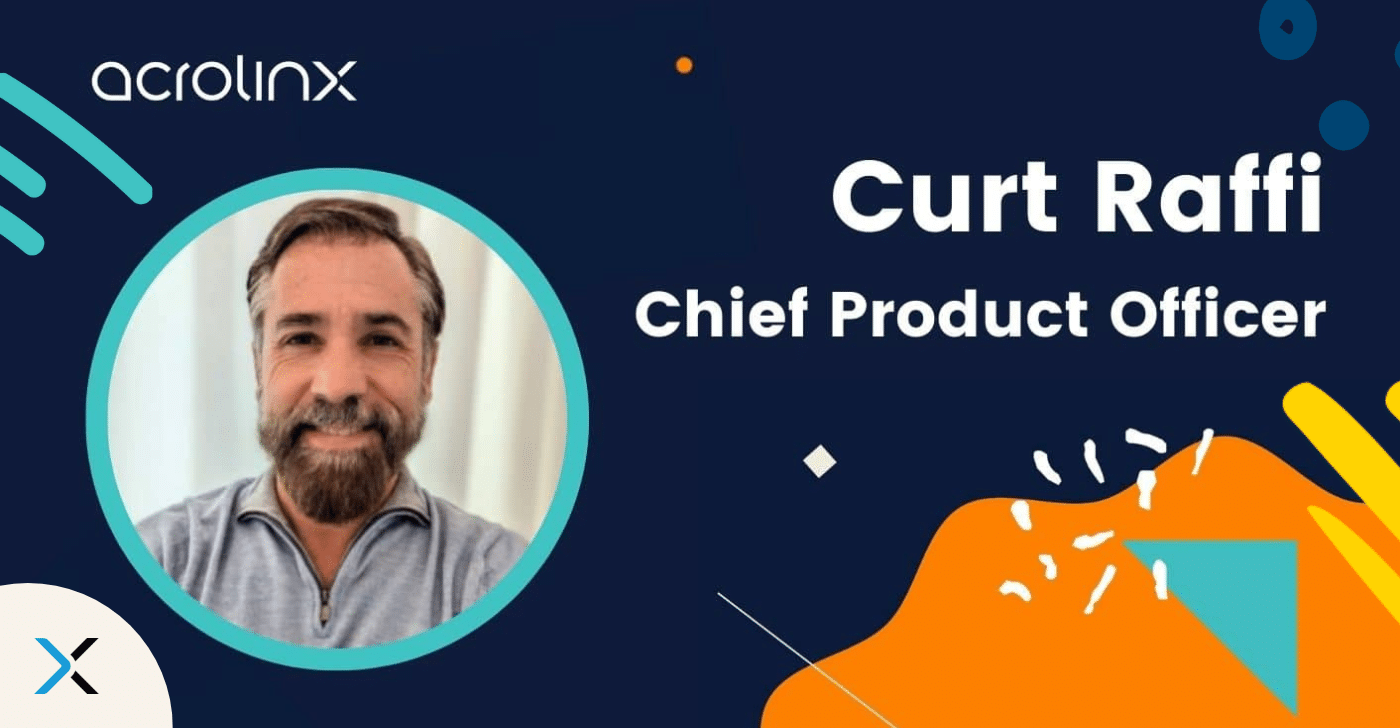
Recently, Acrolinx welcomed a new Chief Product Officer — Curt Raffi. Curt brings more than 20 years of SaaS experience and has a proven track record in leading product management transformations at Bottomline Technologies, Endurance International Group, Fleet Bank, and Salary.com. Curt has led international product, user experience, engineering, data science, marketing, sales, finance, and support teams.
Specializing in product strategy, innovation, and global product management, Curt’s commercial-product approach focuses on market and customer needs, while building sustainable value at the intersection of generative AI and content supply chains. Curt is based in the Boston area, has five children, and loves working on old cars in his spare time.
Charlotte, from the Marketing Team, sat down with Curt for a Q&A about what drew him to Acrolinx, the future of AI and content, and how he sees the Acrolinx product developing. Grab a coffee and enjoy this interview with the latest member of the Acrolinx team!
To start, I’d love to know what drew you to Acrolinx?
Firstly, the team. I love international teams. I was excited to see a number of product and engineering folks in EMEA, as well as in the U.S, and even beyond that — whether it’s in Thailand or Japan. That’s exciting to me. I’ve always found that when you add a multicultural element to building product it gets really fun and exciting. So that was one aspect — the team.
Then also, Acrolinx is at a really interesting point. We provide content governance and have done that in a non-generative AI world. Today we see content governance and content supply chains exploding, as well as the need to align and manage content, not just produce it. We’re able to produce it so quickly and en masse, there’s this convergence that we’ve never seen before and that’s really exciting to me.
I’ve worked in different roles throughout my product journey and at one point I had to produce something like three or four thousand pieces of content. I hired writers to create small business content for apps that I was developing and that was a huge effort. Today you could create those three or four thousand pieces overnight. The rapid pace with which we can create content extends beyond the written word too — with AI-generated video, art, and beyond. It’s creating a whole new need for the types of products that Acrolinx is bringing to market.
I’ve heard the statement that content is now data. Content represents so many different elements, tags, and algorithmic implications that it’s now taking over the world in ways that we had never conceived of. It’s quite an interesting time!
What are you most excited to do as Chief Product Officer at Acrolinx?
To learn from the team! I’ve worked with some very smart teams, but I don’t think I’ve ever been exposed to the kind of technical expertise that I have at Acrolinx. We were founded — really as a research team — in one of the most amazing universities in Germany and that scientific thought process pervades everything we do. So learning from a brilliant team is awesome.
People think that when you come in to lead the product organization that you’re there to drive a mission. I’m actually here to get out of the way of the team and not slow them down, as well as bring what I can to the table. I may not bring the same intellectual horsepower that some of these amazing research scientists and linguists bring, but I’ve been in the product commercialization world for a long time. I provide another lens that we can apply to the product that can be very scientific and engineering focused. How does it feel to use the product? What’s its position in the marketplace? That’s where both my software as a service and commercialization background comes in handy.
With the AI landscape rapidly growing and developing, how do you see Acrolinx in that landscape?
I like to distill things down into simple forms and I create LinkedIn videos where I take concepts that can be confusing and distill them down into easy-to-digest information.
If I had to distill AI, I’d say it’s like raising children. I have five children, and when you’re raising them they can scare you a little, sometimes they can overwhelm you with how they respond in a public setting. AI is a bit like that. It’s like a child learning voraciously. It’s devouring everything and sometimes it can hallucinate or create an outcome that you don’t want, like communicating the wrong thing to your audience.
And that’s the beauty of Acrolinx. Acrolinx enables you to put guardrails and bumpers on your AI output. AI is a great tool and I think generationally it’s changing the way we do work. My daughter is an accountant and she was one of the first people to email me when PwC decided to expand their ChatGPT licenses, I guess they have more than any other corporation on the planet — to help speed the use of AI in the company. And that’s great.
I think we’re going to see more of these AI work products. From our perspective, all of this content is being created and we’ve got to be careful because it may not be in alignment with the way the company talks and that might mean it’s not understood by the customer base or public. So Acrolinx is wonderfully positioned to allow businesses to use AI safely and confidently by making sure generated content matches brand standards.
If you were to look into a crystal ball, what potential do you see for Acrolinx moving forward?
I would say it’s going to play an ever important and expansive role for businesses. I asked one of our large customers recently: What do we do for you? They said that we score content better than anyone else. That’s a very powerful statement from someone that works at one of the biggest corporations on the planet. What do they mean by that? If they write a blog post Acrolinx will measure how their content compares to their guidelines through the Acrolinx Score, and then suggest improvements to improve their score.
The way people interact with Acrolinx is typically through UI, so either the Sidebar or in an application. As we go forward, what I find really interesting are the kind of implications for more deeply integrating Acrolinx AI into the content creation process. Let me make that a little clearer. I think we could support multiple LLMs (large language models) and become the “style guide as a service” — if you will. Perhaps the better way to describe it is “alignment as a service” for the generative AI that corporations create. When AI generates output, Acrolinx can align it to very specific guidelines and ground it to company needs and intent. As we move forward, we could be ubiquitous in guiding all content based on the users’ intent, direction, and guidance, which is a different way of seeing Acrolinx. Ultimately, we’ll be that alignment tool that supports many enterprise LLMs.
What excites you most when you think about AI and content?
AI is fun. Some have positioned AI as this scary, all-knowing thing that’s going to turn us into slave robots, this entity that’s going to take over all of our home controls and turn off our air conditioning when we need it most. I don’t view it as that.
What I really think is that AI is a productive tool. It’s an assistant for all of us — in a very unique way. I’m old enough to remember Clippy, the Microsoft tool. You’d open up Word on a desktop and Clippy, this little animated character, would assist you in writing a document and tell you where you could find things. If Clippy annoyed you, you could shut Clippy off and move on. Most people ended up doing that because Clippy wasn’t very helpful and more like an FAQ page pointing you back to tooltips and PDFs.
The next generation of this type of tool was Siri and Google Assistant. As these products evolved they became more helpful. Even though you could confuse or stump Siri, we advanced to having full-on conversations with these digital assistants. So the full power of that “assistant” element of AI is coming to fruition now and I don’t think it will be just for content. I think it will be for all things.
I love working on old cars. Sometimes old cars are really geeky and weird, in that you don’t fix them the way you might a modern car. Sometimes you have to know or understand forgotten manual processes, but how do you catalog that universe of old knowledge on how to fix an old car? Well, AI would be awesome. My son runs a mechanic facility and he was saying, “Dad, I would love AI to guide all of the mechanics that work for me,” instead of them coming to him and slowing them down during the day.
So where am I going with this? I think AI isn’t something to be feared. Instead it will be in all aspects of our lives and our homes — whether it’s helping unpack financial reporting, aiding auto mechanics, or creating rich technical content, it will be relevant to us all. Ultimately, it brings to fruition this idea of assistance helping you do things more quickly. So that’s what excites me about AI. I’m not afraid of it.
Bonus question: How do you want to put your own stamp on the role?
I’d like the way we approach Product to be more iterative than in the past. One thing that I’ve found is that if everyone can do a couple of things each day to bring new functionality, innovations, or ease of use to customers, especially with a Saas product, it’s incredibly powerful. Everyone talks about moon shot type of products or “let’s do something crazy.” That can be wonderful, but I would much rather see every two weeks or every month, the product become two to two and a half percent more valuable to customers.
I’m also a very visual person. So when I enter a role I immediately run over to the user experience team and say, “can you build me an engageable or clickable Figma of where I want the product to be?” And they all say, “What are you talking about?” I reply, “I want to paint this vision. I want it to really feel like you’re entering this application.” I do that partly to see who will jump on board with me. Ultimately, what I end up finding is a team that gets excited, and they help me create and share a narrative (that’s both visual and spoken) about where the product can go. Then the hive mind kicks in and oftentimes you find the product and journey is way better than you envisioned.
When you’re able to create a clear picture of what we can do together, no one wants to tear it down or slow it down — instead people get excited about actually building it. So that’s one of the things I’d love to do — helping a team create a vision for the future and let them know it’s all about a little bit every month. Let’s not plan on massive releases. Let’s do a lot of really little releases, and it’ll be much easier and less taxing on us and our customers. So that’s what my focus is with the team right now, and they’re wonderfully receptive.
Thanks for joining us for this Q&A with Curt! Make sure to follow Curt on LinkedIn to catch some of his AI explainer videos.
Are you ready to create more content faster?
Schedule a demo to see how content governance and AI guardrails will drastically improve content quality, compliance, and efficiency.

Charlotte Baxter-Read
is a Communications and Content Manager at Acrolinx, bringing over three years of experience in content creation, strategic communications, and public relations. Additionally, Charlotte is the Executive Producer of the WordBirds podcast — sponsored by Acrolinx. She holds a Master’s degree from the John F. Kennedy Institute, at Freie Universität Berlin, and a Bachelor's degree from Royal Holloway, University of London. Charlotte, along with the Acrolinx Marketing Team, won a Silver Stevie Award at the 18th Annual International Business Awards® for Marketing Department of the Year. She's a passionate reader, communicator, and avid traveler in her free time.




